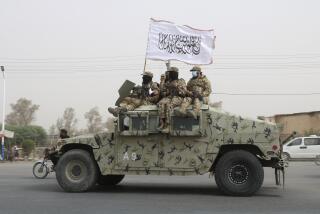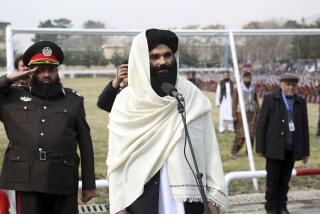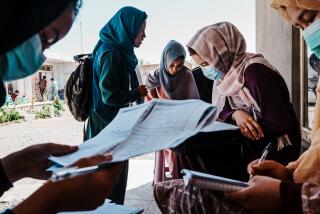Taliban Battle Fiercely to Retain Afghan Capital
- Share via
HUSSEIN KOT, Afghanistan — Pushed back to within 15 miles of the Afghan capital’s heart, the Taliban on Wednesday showered their foes with artillery shells, rockets and tank rounds in a stubborn bid to bar the route to Kabul, the Islamic militia’s greatest prize.
On this barren, dun-colored moonscape north of Kabul, Taliban gunners fired throughout the morning on troops loyal to Ahmed Shah Masoud, the ousted Afghan government’s defense chief, and into hamlets of mud-brick homes where the inhabitants have revolted against the Talibs’ severe version of Sharia, or Islamic law.
“The people of these villages are with them,” admitted Mullah Faisal Mohammed, 24, one of the Taliban’s junior commanders. “But we are not afraid of them, since new fighters from other provinces are coming to join us.”
As the guns thundered, hundreds of residents of Hussein Kot and other rural villages fled south to Kabul on foot or in lurching, overloaded trucks. They carried baskets, teapots, blankets and other prized belongings.
On a parallel road to the east, Taliban artillerymen, tank gunners and crews of multiple-barrel mounted rocket batteries pounded Masoud’s positions around the strategic Bagram air base, which fell to the former government’s forces Saturday.
Despite a string of recent battlefield setbacks, Amir Khan Muttaqi, the Taliban’s information minister, declared at a news conference in Kabul on Wednesday that the army of Muslim purists will never quit the capital, and he rejected Masoud’s precondition for a cease-fire.
“The areas we have captured, have under our control and where we have instituted the Sharia--we will defend these areas to the last drop of our blood,” Muttaqi said.
The information minister in Kabul’s provisional government, which has yet to be recognized formally by any foreign country, said the Taliban would agree to a cease-fire “for the sake of the nation” but that the former government’s forces would have to agree first to release hundreds of Talib fighters they have captured.
The failure of the Taliban’s main foreign backer, Pakistan, to broker an end to the latest round of fighting presages continuing armed strife in a country where more than 1 million people have already perished in 17 years of warfare.
Masoud, who may have fewer than 5,000 men, now appears to be too weak to storm the capital, while the Taliban’s northward momentum has been reversed.
The strategy of Masoud, probably the most famous of the moujahedeen leaders to have fought the 1979-89 Soviet occupation of Afghanistan, appears to be to bleed the Taliban by drawing as many of their fighters into combat as possible while encircling Kabul and cutting some of its main road links.
As well as blocking the main highway leading north from Kabul to the Amu Darya river and the former Central Asian republics of the Soviet Union, Masoud’s forces on Wednesday were also reported to have taken some of the high ground east of the capital. This would let them bombard the main land artery linking Kabul and Pakistan via the Khyber Pass.
The ultimate intentions of the third player in Afghan’s power politics, the Uzbek warlord Abdul Rashid Dostum, are the X factor in the equation that will determine Afghanistan’s future.
Dostum, a former general in the Communist regime ousted in 1992, signed a defense alliance this month with Masoud and apparently is giving him supplies.
But Dostum’s well-equipped militia, believed to number up to 30,000 men, appears to have played no major part to date in the battles against the Taliban; Dostum is being wooed by the Islamic fundamentalists as a potential ally.
Although some news reports have said Dostum’s Uzbeks have fought beside Masoud’s predominantly Tajik force, Muttaqi said he could not confirm that.
The Taliban, a die-hard Muslim militia that arose two years ago in mosque schools along the Afghan-Pakistani border, rolled into Kabul on Sept. 27, putting forces loyal to Masoud and President Burhanuddin Rabbani to flight.
Within days, the Talibs, mainly members of Afghanistan’s dominant Pushtun ethnic group, were masters of much of the country.
It was their high-water mark. In fighting that followed as they drove north of Kabul toward the snow-dusted Hindu Kush mountains, the Taliban may have lost 1,500 of their most experienced fighters and commanders.
Masoud attacked his enemies on the road to the Salang Tunnel, 60 miles north of Kabul, and split them into small pockets. Informed sources in Kabul said hundreds of Talibs were killed, wounded and captured; at least 17 armored vehicles were abandoned.
In the Shomali valley north of Kabul, villagers revolted against the Talibs’ strict, puritanical style of Islamic law. Talibs retaliated by burning down homes and killing some of the mutineers.
Masoud’s troops, therefore, found ready allies among the villagers when they attacked the town of Jabal os Saraj astride the main road to the capital, cutting off an estimated 1,700 Taliban to the north, up to 400 of whom may have been taken prisoner.
Despite the Taliban’s public show of bravado, signs of strain in parrying the threat from Masoud are evident.
In August, the U.N. estimated that the Talibs had 50,000 men and boys under arms. But now sources say the Islamic militia has been filling the holes in its ranks by dragooning young men in the Pushtun provinces of the east and south.
More to Read
Sign up for Essential California
The most important California stories and recommendations in your inbox every morning.
You may occasionally receive promotional content from the Los Angeles Times.










